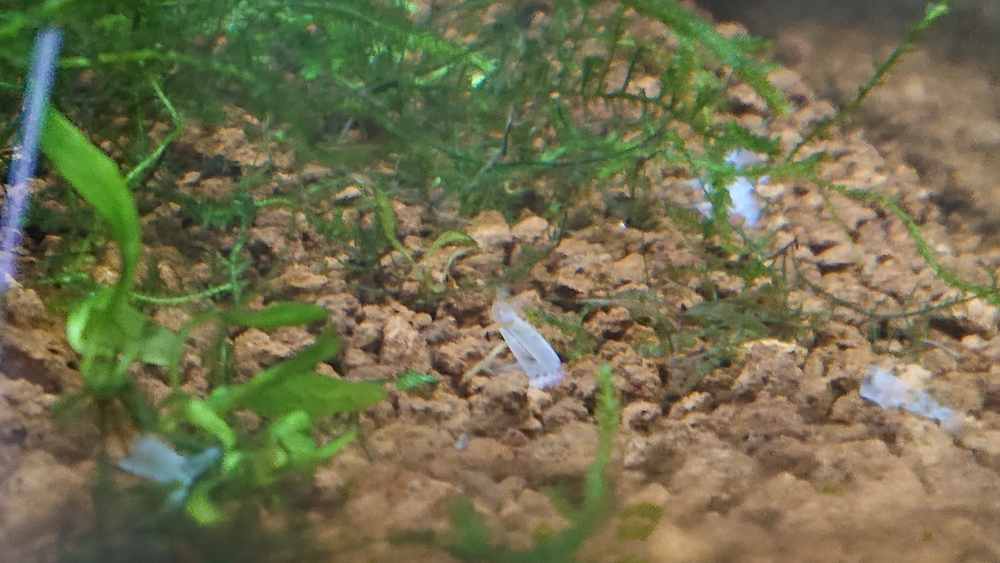Shrimp molt regularly as part of their natural development cycle. However, they sometimes molt irregularly if there are detrimental health or environmental issues. Can water change in tanks lead to shrimps molting, though?
Water changes in a tank don’t cause shrimp to molt because they molt naturally. However, if you add too much water or too frequently, the change in water parameters, such ass pH, temperature, or GH, the shrimp may molt irregularly.
In this article, I’ll discuss if and when water changes in your shrimp tank can cause shrimp to molt. Then, I’ll explain everything you should know about the correct water cycle, including the number of water parameters and how frequently you should change the tank water.

Why Water Changes in a Tank May Cause Shrimp to Molt
Shrimp change their exoskeletons frequently because they outgrow them as they develop. Molting happens every few weeks with shrimps. Depending on the shrimp species you own, they can molt every 4 to 6 weeks (some every eight weeks).
Female shrimp molt more frequently and around the reproductive period as part of the fertilization process. During that period, molting results from reproduction, not shrimp growth.
While there’s nothing wrong with molting, it can be a sign something’s wrong with your shrimp or the tank. If your shrimp molts irregularly, you must change the diet or the tank water. New owners sometimes forget the importance of water change and sometimes forget to measure the water’s parameters.
Irregular molting won’t directly kill shrimp, but underlying conditions, such as the White Ring of Death, can.
Below are the reasons water changes in tanks may cause shrimp to molt:
Irregular Water Parameters
Water parameters play a crucial role in the healthy shrimp molting process. Shrimp need minerals and healthy bacteria to molt properly. Higher levels of nitrates, ammonia, chlorine, and chloramine can lead to irregular molting and even death.
When changing the water in your shrimp tank, you need to pay attention to the following:
- Water temperature
- GH (General Hardness)
- TDS (Total Dissolved Solids)
- KH (Carbonate Hardness)
- pH
- Iodine
What Are The Ideal Water Parameters for a Shrimp Tank?
Before discussing the ideal water parameters for a shrimp tank, it’s important to remember that different shrimp species require different water parameters. You should always check the exact parameters for your shrimp.
Keeping the water perfect for molting is crucial, and you’ll need a TDS tester and a pH meter. The TDS level should normally be around 100-150. Some species, like red cherry shrimp, require TDS of up to 200.
The correct amount of TDS ensures a healthy molting process.
You also want to keep the nitrate levels in check, as they shouldn’t exceed 20 ppm. Nitrates are less harmful than ammonia, which must be at 0. However, anything over 20 ppm of nitrate requires a water change.
Many shrimp owners without RO filters opt for RO (reverse osmosis) water since it’s pure H2O without contaminants. The two frequent contaminants you should keep away from shrimp are chlorine and chloramine. If using tap water, leave it overnight, and the chlorine will disappear. Since chloramine contains ammonia, you’ll need to use a dechlorinator.
If you’re using RO water, buy minerals suitable for shrimp and remineralize the water. Otherwise, your shrimp won’t benefit from the minerals they need to survive and molt.
Once you’ve prepared the water, you should leave it overnight for a few reasons:
- The water will reach room temperature.
- The pH will have time to stabilize in the water.
- The chlorine can evaporate.
This is called aging the water, and it ensures shrimp don’t go into shock due to water change. For most shrimp species, the best temperature is around 73 °F (21 °C), and the pH level should be about 7 (neutral).
Lastly, GH and KH vary depending on the species. Most species typically require the GH to be between 4 and 6. Some shrimp, like Tiger and Blue Tiger, require a GH of between 4 and 8. Harlequin and Cardinal shrimp prefer a GH of 7 to 9.
KH levels generally range from 0 and 2 but can go as high as 9.
Water Changes Can Stress Shrimp and Cause Molting Issues
Sudden water changes can cause shrimp to go into shock. That’s why it’s crucial to:
- Prepare the new water according to the correct parameters.
- Leave the water for at least 24 hours before introducing shrimp to the tank.
If the water parameters are wrong, you’ll get two different concentrations of water, which can lead to osmosis. When that happens, the shrimp’s cells absorb more water and expand to reduce the saline. This can lead to your shrimp dying from hypertrophy.
An excess of TDS can also cause stress and, ultimately, death.
How Much Water Should You Change in a Shrimp Tank?
You should never empty the entire tank, as this would lead to shock and cause your shrimp to die. Always change between 10% and 20% of the water from a tank. This is enough for healthy acclimatization. Change the water every one to two weeks.
If you remove 10% of the water from the tank, ensure that you add the same amount of new water back. The water change frequency depends on the parameters and your tank’s setup. If you have some plants in the tank, they’ll reduce the nitrates, and you won’t have to change the water as frequently.
If the parameters are acceptable for your shrimp species, you won’t have to change the water, even if it’s been two weeks. You can do a water change only when you notice higher levels of nitrates (over 20 ppm) and TDS.
Once the new water is ready and you’ve waited at least 24 hours, you can add the water slowly to the tank. Many owners use small tubes or pipes and let the water drip into the tank. You can also add it using a cup but just do it slowly.
Final Thoughts
Shrimp molt naturally throughout their lives. This process occurs every few weeks, depending on age and species. However, shrimp can irregularly molt if there’s something wrong with their health or tank. Water change is a common reason shrimp molt, and this can be serious.
You should always change around 10% of the tank water every two weeks. You’ll need the same water parameters, like temperature, pH, GH, and KH, between the old and the new water. Keep the TDS around 150 for most species.
Helpfull Posts
- What are the perfect Cherry shrimp water parameters
- How To Make Your Crystal Red Shrimp Live in Hard Water
- Can Crystal Red Shrimp Live in Hard Water?
- Can Any Kind of Shrimp Survive in Freshwater?
Sources
- ScienceDirect: Hypertrophy
- Britannica: Osmosis
- Medium: Is Reverse Osmosis Water Good (or Bad) For Us?
- Shrimpplanet: Why Are My Shrimp Dying? (A Guide to Prevent Shrimp Death)
- Inter-Research Science Publisher: Moult Activity-Related Spawning Success in the Mediterranean Deep-Water Shrimp Aristeus Antennatus (Decapoda: Dendrobranchiata)
- Shrimp Science: Shrimp Tank Water Changes: A Simple Guide
- Shrimp Science: Molting and Common Problems
- Shrimp Tank Talk: Shrimp Tank Water Change: Everything You Need To Know
- Fish Keeping Trends: How Often Do Cherry Shrimp Molt?
- The Aquarium Adviser: Water Parameters Needed For Shrimp: Temperature, KH, pH & TDS
- Aquarium Breeder: How to Do and How Often to Do Water Change in Shrimp Aquarium
Recent Posts
How Do Freshwater Shrimps Live? Freshwater shrimp are fascinating creatures that play a crucial role in aquatic ecosystems. They help maintain water quality by consuming algae and decomposing...
How Many Freshwater Shrimp Per Gallon? 4 Key Factors Freshwater shrimp are popular additions to aquariums, but many hobbyists wonder: how many shrimp can comfortably live in a gallon of water? The...

